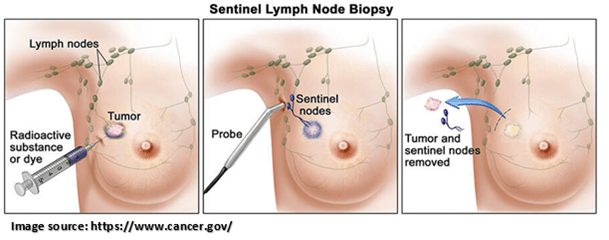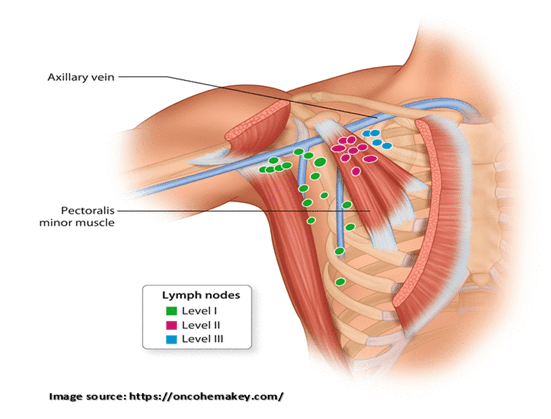
Axillary Surgery in Mumbai
If you are diagnosed with breast cancer, your breast cancer surgeon in Mumbai might advise having an axillary surgery, also known as axillary lymph node dissection. For years, this surgery has been regarded as essential in managing breast cancer to prevent the spread of the disease or its recurrence.
Dr. Garvit Chitkara is a skilled and experienced breast cancer surgeon in Mumbai. He has over 14 years of experience in general practice and over ten years of experience in breast surgical oncology.
Moreover, Dr. Garvit Chitkara specializes in oncoplastic breast surgeries and is renowned for providing the best axillary surgery in Mumbai. He is a reputed breast oncology surgeon in Mumbai who offers comprehensive breast cancer care.
Learn more about how axillary surgery works and what you should know about its potential risks and the recovery process.
Get Consultation from Dr. Garvit
Why is axillary surgery required?
Axillary surgery is an essential part of breast cancer surgery and it helps the oncologists decide the stage of the disease, the chances of recurrence, the need and amount of chemotherapy, and the need for radiotherapy.
Depending on the clinical examination and radiology it is decided what axillary surgery needs to be done. For a clinically node-negative axilla a sentinel lymph node biopsy is advised. In clinically node-positive axilla Axillary Lymph node Dissection (ALND) is recommended which is the removal of all the fibrofatty tissue in the axilla. Anatomically there are three levels of the axilla. The level of dissection may vary from patient to patient and is best decided by the operating surgeon.
Types of Axillary Surgery
1. Sentinel Lymph Node Biopsy (SLNB)
Surgeons often perform SLNB when there is no confirm diagnosis that cancer has spread to the lymph nodes. The sentinel node or nodes are one of a series of lymph nodes in the underarm that drains lymph fluid from the breast first. Lymph is a slow-moving fluid that carries heavy proteins from various parts of the body toward the central circulation.
Carcinoma cells generally travel in these lymphatic vessels and get lodged in the lymph nodes. SLNB is one such identification technique to find out which of the lymph nodes may have cancer cells. These lymph nodes are biopsied (taken out) and sent for microscopic examination.
The lymphoscintigraphy mapping process can be used to locate the sentinel nodes before surgery. This is accomplished by injecting a minimal quantity of radioactive tracer fluid into the breast, usually close to the areola or close to the tumour. Along with the radiotracer a color dye is also used to help identify the sentinel nodes. The double dye technique is the gold standard and is recommended internationally.
The first node(s) to absorb this fluid will be the sentinel node(s). A scan is carried out to produce an image that shows the precise location of the node(s) that the surgeon should remove. In the theatre a gamma ray detection probe is used to identify these nodes and then they are sent to for microscopic examination and a decision is taken to do an ALND or not based on this report.
The Centers that have frozen section facility are able to do this procedure in a single setting else it requires two surgeries. Dr. Garvit Chitkara is able to do this in a single setting with a double-dye technique
2. Axillary Lymph Node Dissection (ALND)
Dr. Garvit Chitkara, a proficient breast cancer surgeon in Mumbai, performs this procedure in some breast cancer cases where the tumors have spread to the lymph nodes under the arms (axilla) or of. A sentinel lymph node biopsy is positive for metastasis to the nodes.
An axillary node dissection is required to remove the nodes in levels one and two of the axillae when diagnostic tests performed before surgery have revealed cancer cells in lymph nodes. As the number of lymph nodes in each level varies from person to person, this may involve five to thirty nodes.
There are three levels of lymph nodes in the axilla; the decision to remove level three is taken based on the patient and the burden of the disease in the lower axilla. If the disease burden is high the level three dissection is carried out.
The number of nodes that were removed and how many of those nodes contained cancer cells will be noted in the pathology report after the pathologist has examined the removed nodes.
Compared to sentinel node biopsy, ALND carries a higher risk of lymphoedema in the affected arm.
How Is Axillary Lymph Node Dissection Performed?
With an ALND, the actual lymph node removal procedure lasts about an hour. Depending on the facility and how you react to the surgery, you might spend most of the day at the hospital.
You will be given general anesthesia before your procedure.
Your surgeon may make a 2 to 3 inches underarm incision during the procedure, typically along a crease, to help reduce scarring. Then, the surgeon will stitch the incision together after removing the suspected cancerous lymph nodes.
This procedure might be combined with a lumpectomy. An ALND might also involve a mastectomy if you have invasive breast cancer.
You will be taken to a recovery area after surgery, where you will awaken naturally from anesthesia.
A drainage system is attached to the axilla post-axillary surgery to help reduce the chances of seroma formation. The drain can be left inside from 2 to 14 days depending on the amount of fluid that drains.
A drainage system is attached to the axilla post-axillary surgery to help reduce the chances of seroma formation. The drain can be left inside from 2 to 14 days depending on the amount of fluid that drains.
How Long Does It Take To Recover From An Axillary Lymph Node Dissection?
ALND is considered major surgery, necessitating home care before you can return to regular activities. Following surgery, you might experience swelling for up to a week. Full recovery should take 4 weeks.
Your doctor may prescribe pain medications to take as needed. Additionally, you will receive instructions on how to take care of your drains and stitches and when to visit your doctor to have them removed.
After 24 hours, you should be able to take a shower. However, you should hold off on taking a bath or swimming until your doctor gives the all-clear at your follow-up appointment after surgery.
Additionally, until your surgeon says it is safe, avoid applying lotions, deodorants, or powders near the affected area.
Your doctor may advise daily hand and arm exercises to reduce swelling and improve mobility while preventing complications.
Get in touch with Dr. Garvit
What Are The Possible Side Effects Of Axillary Lymph Node Dissection?
Although an ALND may be required to stop the spread of breast cancer, this major procedure carries a risk of side effects.
For instance, removing lymph nodes could make you more susceptible to lymphedema. Where your lymph nodes once were, lymph fluid may build up and cause this condition.
Redness
Swelling
Tenderness
Fever
Leathery skin
Numbness or tingling
Loss of arm movement
Lymphedema can appear immediately following surgery, or it can take months or years to manifest.
Infection
Bleeding
Numbness
Fluid accumulation under your arms
Inflammation of the arm veins
Blood clotting
Call your doctor immediately if you experience any of the above mentioned signs or symptoms after your procedure.
Takeaway
Potentially cancerous tumors in your underarm lymph nodes can be removed using an ALND. This procedure may be combined with others to treat breast cancer to prevent the disease’s spread.
While your overall breast cancer treatment plan may include an ALND, discussing all risks and potential complications with your surgeon before the procedure is crucial.
Carefully adhere to all aftercare instructions to aid in better healing and mobility.
Make an Appointment
Frequently Asked Questions
How successful is axillary lymph node dissection in preventing the recurrence of cancer?
To help stop the spread of cancer, an ALND is performed. This procedure is still essential for giving you an accurate prognosis, preventing the spread of breast cancer, and improving your chances of survival.
What are the primary complications with axillary dissection?
Axillary dissection complications can include wound infections, arm movement restrictions, arm numbness, arm lymphedema, and lymphangitis.
Can nerve damage result from lymph node removal?
During surgery, the nerve that produces sensation to the armpit and back of the arm may occasionally be cut, stretched, or otherwise harmed. This loss of sensation might only last for a short while, but for some women, it might be for the long term.
How soon after having lymph nodes removed can you drive?
At your post-op check, your surgeon would go over exercises if more than six lymph nodes had been removed. Most patients can drive one week after surgery, provided they haven’t taken any narcotic painkillers in the last 48 hours.
What precautions do you need to take post surgery to avoid lymphedema?
- Avoid injury to the operated side arm. It’s easier said than done as patients where the dominant hand side is operated are likely to have small cuts and bruise while doing their daily works. These cuts and bruises tend to increase the rate of infection and lymphedema
- Although the scientific evidence supporting it is less but its advised to not use the operated side hand for blood tests or even BP measurement as the pressure applied can dmage the superficial lymphatics thereby increasing lymphedema
- See your doctor if you notice any change in size/ girth of the arm


